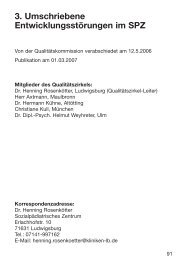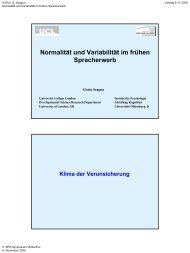(Central) Auditory Processing Disorders - Technical Report
(Central) Auditory Processing Disorders - Technical Report
(Central) Auditory Processing Disorders - Technical Report
- No tags were found...
You also want an ePaper? Increase the reach of your titles
YUMPU automatically turns print PDFs into web optimized ePapers that Google loves.
20 / 2005<br />
American Speech-Language-Hearing Association<br />
Appendix: Definition of Terms Used in This Document<br />
• Assessment: Formal and informal procedures<br />
to collect data and gather evidence (i.e., delineation<br />
of functional areas of strength or weakness<br />
and/or determination of ability or<br />
capacity in associated areas).<br />
• Comorbidity: The coexistence of two or more<br />
disorders, diseases, or pathologic processes<br />
that are not necessarily related.<br />
• Diagnosis: Identification and categorization of<br />
impairment/dysfunction (i.e., determination<br />
of presence and nature of disorder).<br />
• Differential diagnosis: Distinguishing between<br />
two or more conditions presenting with similar<br />
symptoms or attributes.<br />
• Evaluation: Interpretation of assessment data,<br />
evidence, and related information.<br />
• Intervention: Comprehensive, therapeutic<br />
treatment and management of a disorder.<br />
• Management: Procedures (e.g., compensatory<br />
strategies, environmental modifications) targeted<br />
toward reducing the effects of a disorder<br />
and minimizing the impact of the deficits<br />
that are resistant to remediation.<br />
• Pansensory: Referring to higher level mechanisms<br />
that are common to and that support<br />
processing across all modalities.<br />
• Prevention: Procedures targeted toward reducing<br />
the likelihood that impairment will<br />
develop.<br />
• Reliability: The consistency, dependability,<br />
reproducibility, or stability of a measure.<br />
• Remediation/treatment: Procedures targeted<br />
toward resolving the impairment.<br />
• Screening: Procedures used to identify individuals<br />
who are “at-risk” for an impairment.<br />
• Validity: The degree to which a test measures<br />
what it is intended to measure.







